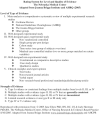Care of chronic wounds in palliative care and end-of-life patients
- PMID: 20528993
- PMCID: PMC7951627
- DOI: 10.1111/j.1742-481X.2010.00682.x
Care of chronic wounds in palliative care and end-of-life patients
Abstract
The aim of this paper was to provide a literature synthesis on current wound care practices for the management of chronic wounds in palliative care and end-of-life patients, focusing on the control of wound-related symptoms for comfort and improved quality of life. These wounds included pressure ulcers, venous and arterial leg ulcers, diabetic ulcers and fungating malignant wounds. Wound-related symptoms included pain, exudate, malodour, infection, bleeding, dressing comfort and negative psychological and social functioning. Best care wound practices were formulated for each wound type to ease suffering based on the literature review. Although symptom management strategies for comfort may work in tandem with healing interventions, it is important to recognise when efforts towards wound closure may become unrealistic or burdensome for the patient at end of life. Thus, unique aspects of palliative wound care feature clinical indicators for early recognition of delayed healing, quality of life measurement tools related to chronic wounds, and comfort care strategies that align with patient wishes and realistic expectations for wound improvement.
Figures
Similar articles
-
When the goal is palliative care.Adv Skin Wound Care. 2006 Apr;19(3):148-54. doi: 10.1097/00129334-200604000-00010. Adv Skin Wound Care. 2006. PMID: 16639221 Review.
-
The reality of routine practice: a pooled data analysis on chronic wounds treated with TLC-NOSF wound dressings.J Wound Care. 2017 Feb;26(Sup2):S4-S15. doi: 10.12968/jowc.2017.26.Sup2.S4. J Wound Care. 2017. PMID: 28182533
-
Use of a next-generation multilayered foam dressing in hard-to-heal wounds: a prospective, multicentre study.J Wound Care. 2025 Feb 2;34(2):154-162. doi: 10.12968/jowc.2024.0416. Epub 2025 Jan 27. J Wound Care. 2025. PMID: 39928474
-
Evidence-based management of chronic wounds.Adv Skin Wound Care. 2007 Nov;20(11):591-600. doi: 10.1097/01.ASW.0000284936.32707.8d. Adv Skin Wound Care. 2007. PMID: 17975367 Review.
-
Symptom burden and quality of life in patients with malignant fungating wounds.J Adv Nurs. 2012 Jun;68(6):1312-21. doi: 10.1111/j.1365-2648.2011.05839.x. Epub 2011 Nov 1. J Adv Nurs. 2012. PMID: 22043819
Cited by
-
Management of Infections in Palliative Care Patients at the End-of-Life and Active Process of Death: A Brazilian Retrospective Study.Palliat Med Rep. 2024 Aug 2;5(1):324-330. doi: 10.1089/pmr.2024.0005. eCollection 2024. Palliat Med Rep. 2024. PMID: 39144136 Free PMC article.
-
Treatment Algorithm for Cancerous Wounds: A Systematic Review.Cancers (Basel). 2022 Feb 25;14(5):1203. doi: 10.3390/cancers14051203. Cancers (Basel). 2022. PMID: 35267512 Free PMC article. Review.
-
Diagnostic Accuracy of Microsoft's Copilot Artificial Intelligence in Chronic Wound Assessment: A Comparative Study.Plast Reconstr Surg Glob Open. 2025 Jun 12;13(6):e6871. doi: 10.1097/GOX.0000000000006871. eCollection 2025 Jun. Plast Reconstr Surg Glob Open. 2025. PMID: 40510430 Free PMC article.
-
Biomedical Biopolymers, their Origin and Evolution in Biomedical Sciences: A Systematic Review.J Clin Diagn Res. 2015 Sep;9(9):ZE21-5. doi: 10.7860/JCDR/2015/13907.6565. Epub 2015 Sep 1. J Clin Diagn Res. 2015. PMID: 26501034 Free PMC article. Review.
-
Pressure ulcers in palliative ward patients: hyponatremia and low blood pressure as indicators of risk.Clin Interv Aging. 2016 Dec 29;12:37-44. doi: 10.2147/CIA.S122464. eCollection 2017. Clin Interv Aging. 2016. PMID: 28096663 Free PMC article.
References
-
- National Consensus Project for Quality Palliative Care . Clinical practice guidelines for quality palliative care, 2nd edn, 2009. National Consensus Project, Pittsburgh, PA, USA. URL http://www.nationalconsensusproject.org/Guidelines_download.asp‐8k‐cached [accessed 29 June 2009].
-
- The World Health Organization . The World Health Organization quality of life (WHOQOL)‐BREF. 2004, 1–5. URL http://www.who.int/substance_abuse/research/tools/whoqolbref/en [access ed 29 June 2009].
-
- Institute for Clinical Systems Improvement . Health care order set: palliative care. November 2007. URL http://www.icsi.org [accessed 20 May 2009].
-
- Alvarez OM, Meehan M, Ennis W, Thomas DR, Ferris FD, Kennedy KL, Rogers R, Bradley M, Baker JJ, Fernandez‐Obregon A, Rodeheaver G. Chronic wounds: palliative management for the frail population. Wounds 2002;14(8 Suppl): 4S–27S.
-
- Brown G. Long‐term outcomes of full‐thickness pressure ulcers: healing and mortality. Ostomy Wound Manage 2003;49(10):42–50. - PubMed
Publication types
MeSH terms
LinkOut - more resources
Full Text Sources
Medical




